Leadership and Change Management in Retail: Debenhams Analysis
VerifiedAdded on 2023/01/12
|21
|6557
|1
Report
AI Summary
This report provides a comprehensive analysis of organisational change and leadership, using Debenhams as a case study. It begins with an introduction to change management and its significance, followed by a comparison of Debenhams with House of Fraser, highlighting the impacts of changes on their strategies and operations. The report then assesses various change drivers, both external (political, economic, social, technological, legal, and ecological) and internal, and evaluates their effects on individual, team, and leadership behaviors. It explores ways to minimize negative impacts, applying relevant theories and models. Further, the report delves into change barriers, their influence on leadership decision-making, and the application of Force Field Analysis. Finally, it examines different leadership approaches for dealing with change, evaluating their effectiveness and concluding with recommendations for planning and implementing change within organisations. The report includes detailed comparisons, evaluations, and critical analyses to provide a thorough understanding of the subject.
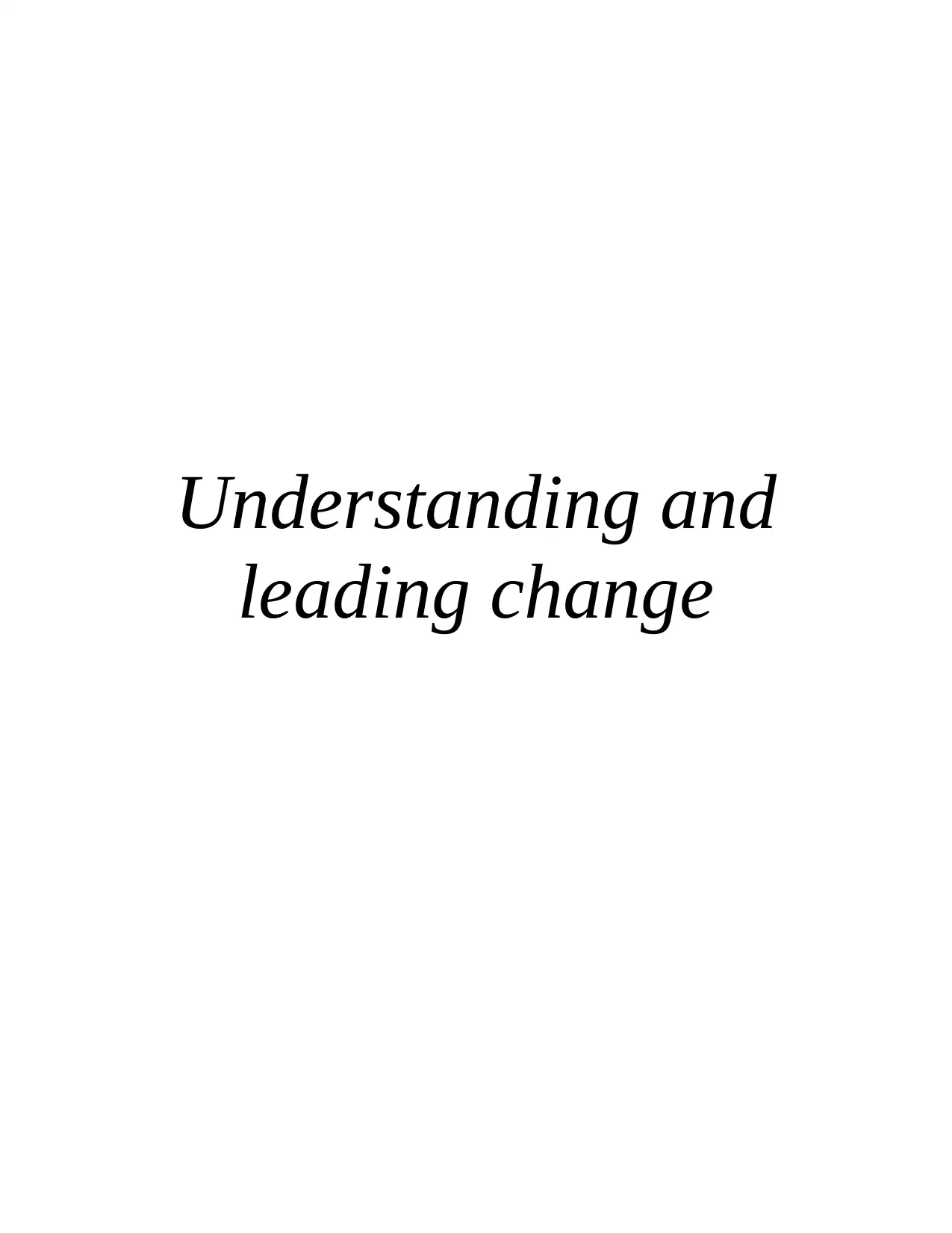
Understanding and
leading change
leading change
Paraphrase This Document
Need a fresh take? Get an instant paraphrase of this document with our AI Paraphraser
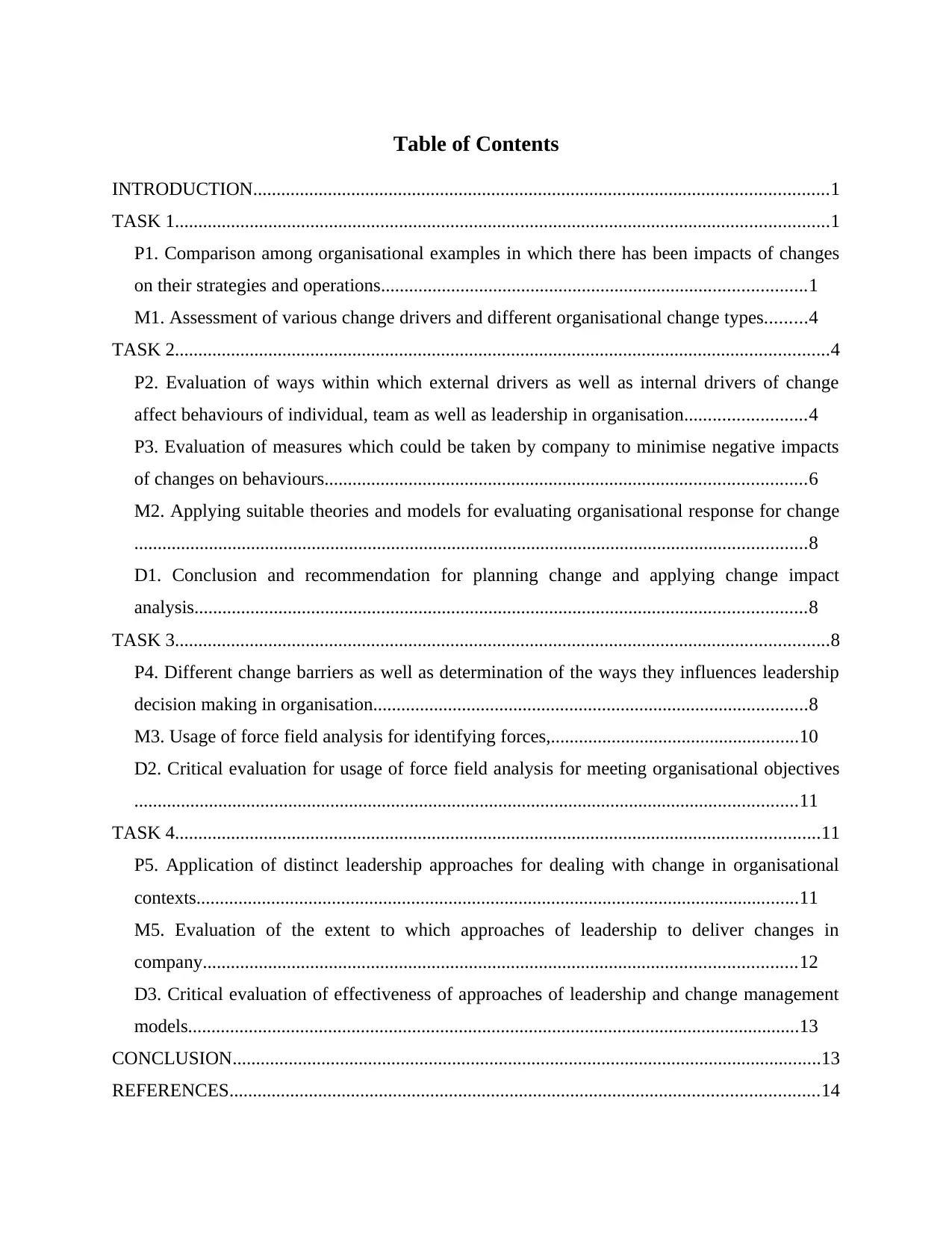
Table of Contents
INTRODUCTION...........................................................................................................................1
TASK 1............................................................................................................................................1
P1. Comparison among organisational examples in which there has been impacts of changes
on their strategies and operations...........................................................................................1
M1. Assessment of various change drivers and different organisational change types.........4
TASK 2............................................................................................................................................4
P2. Evaluation of ways within which external drivers as well as internal drivers of change
affect behaviours of individual, team as well as leadership in organisation..........................4
P3. Evaluation of measures which could be taken by company to minimise negative impacts
of changes on behaviours.......................................................................................................6
M2. Applying suitable theories and models for evaluating organisational response for change
................................................................................................................................................8
D1. Conclusion and recommendation for planning change and applying change impact
analysis...................................................................................................................................8
TASK 3............................................................................................................................................8
P4. Different change barriers as well as determination of the ways they influences leadership
decision making in organisation.............................................................................................8
M3. Usage of force field analysis for identifying forces,.....................................................10
D2. Critical evaluation for usage of force field analysis for meeting organisational objectives
..............................................................................................................................................11
TASK 4..........................................................................................................................................11
P5. Application of distinct leadership approaches for dealing with change in organisational
contexts.................................................................................................................................11
M5. Evaluation of the extent to which approaches of leadership to deliver changes in
company...............................................................................................................................12
D3. Critical evaluation of effectiveness of approaches of leadership and change management
models...................................................................................................................................13
CONCLUSION..............................................................................................................................13
REFERENCES..............................................................................................................................14
INTRODUCTION...........................................................................................................................1
TASK 1............................................................................................................................................1
P1. Comparison among organisational examples in which there has been impacts of changes
on their strategies and operations...........................................................................................1
M1. Assessment of various change drivers and different organisational change types.........4
TASK 2............................................................................................................................................4
P2. Evaluation of ways within which external drivers as well as internal drivers of change
affect behaviours of individual, team as well as leadership in organisation..........................4
P3. Evaluation of measures which could be taken by company to minimise negative impacts
of changes on behaviours.......................................................................................................6
M2. Applying suitable theories and models for evaluating organisational response for change
................................................................................................................................................8
D1. Conclusion and recommendation for planning change and applying change impact
analysis...................................................................................................................................8
TASK 3............................................................................................................................................8
P4. Different change barriers as well as determination of the ways they influences leadership
decision making in organisation.............................................................................................8
M3. Usage of force field analysis for identifying forces,.....................................................10
D2. Critical evaluation for usage of force field analysis for meeting organisational objectives
..............................................................................................................................................11
TASK 4..........................................................................................................................................11
P5. Application of distinct leadership approaches for dealing with change in organisational
contexts.................................................................................................................................11
M5. Evaluation of the extent to which approaches of leadership to deliver changes in
company...............................................................................................................................12
D3. Critical evaluation of effectiveness of approaches of leadership and change management
models...................................................................................................................................13
CONCLUSION..............................................................................................................................13
REFERENCES..............................................................................................................................14

⊘ This is a preview!⊘
Do you want full access?
Subscribe today to unlock all pages.

Trusted by 1+ million students worldwide
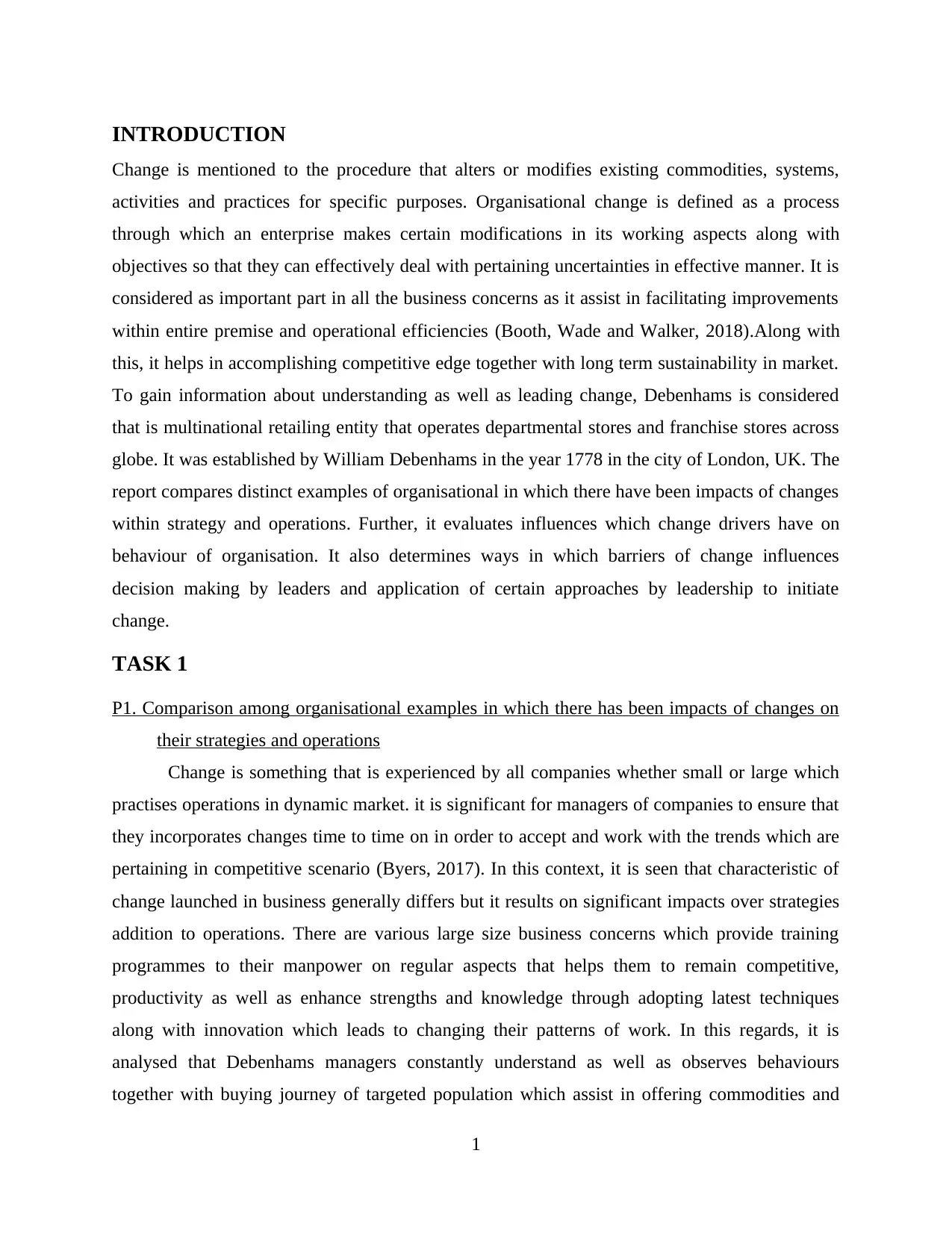
INTRODUCTION
Change is mentioned to the procedure that alters or modifies existing commodities, systems,
activities and practices for specific purposes. Organisational change is defined as a process
through which an enterprise makes certain modifications in its working aspects along with
objectives so that they can effectively deal with pertaining uncertainties in effective manner. It is
considered as important part in all the business concerns as it assist in facilitating improvements
within entire premise and operational efficiencies (Booth, Wade and Walker, 2018).Along with
this, it helps in accomplishing competitive edge together with long term sustainability in market.
To gain information about understanding as well as leading change, Debenhams is considered
that is multinational retailing entity that operates departmental stores and franchise stores across
globe. It was established by William Debenhams in the year 1778 in the city of London, UK. The
report compares distinct examples of organisational in which there have been impacts of changes
within strategy and operations. Further, it evaluates influences which change drivers have on
behaviour of organisation. It also determines ways in which barriers of change influences
decision making by leaders and application of certain approaches by leadership to initiate
change.
TASK 1
P1. Comparison among organisational examples in which there has been impacts of changes on
their strategies and operations
Change is something that is experienced by all companies whether small or large which
practises operations in dynamic market. it is significant for managers of companies to ensure that
they incorporates changes time to time on in order to accept and work with the trends which are
pertaining in competitive scenario (Byers, 2017). In this context, it is seen that characteristic of
change launched in business generally differs but it results on significant impacts over strategies
addition to operations. There are various large size business concerns which provide training
programmes to their manpower on regular aspects that helps them to remain competitive,
productivity as well as enhance strengths and knowledge through adopting latest techniques
along with innovation which leads to changing their patterns of work. In this regards, it is
analysed that Debenhams managers constantly understand as well as observes behaviours
together with buying journey of targeted population which assist in offering commodities and
1
Change is mentioned to the procedure that alters or modifies existing commodities, systems,
activities and practices for specific purposes. Organisational change is defined as a process
through which an enterprise makes certain modifications in its working aspects along with
objectives so that they can effectively deal with pertaining uncertainties in effective manner. It is
considered as important part in all the business concerns as it assist in facilitating improvements
within entire premise and operational efficiencies (Booth, Wade and Walker, 2018).Along with
this, it helps in accomplishing competitive edge together with long term sustainability in market.
To gain information about understanding as well as leading change, Debenhams is considered
that is multinational retailing entity that operates departmental stores and franchise stores across
globe. It was established by William Debenhams in the year 1778 in the city of London, UK. The
report compares distinct examples of organisational in which there have been impacts of changes
within strategy and operations. Further, it evaluates influences which change drivers have on
behaviour of organisation. It also determines ways in which barriers of change influences
decision making by leaders and application of certain approaches by leadership to initiate
change.
TASK 1
P1. Comparison among organisational examples in which there has been impacts of changes on
their strategies and operations
Change is something that is experienced by all companies whether small or large which
practises operations in dynamic market. it is significant for managers of companies to ensure that
they incorporates changes time to time on in order to accept and work with the trends which are
pertaining in competitive scenario (Byers, 2017). In this context, it is seen that characteristic of
change launched in business generally differs but it results on significant impacts over strategies
addition to operations. There are various large size business concerns which provide training
programmes to their manpower on regular aspects that helps them to remain competitive,
productivity as well as enhance strengths and knowledge through adopting latest techniques
along with innovation which leads to changing their patterns of work. In this regards, it is
analysed that Debenhams managers constantly understand as well as observes behaviours
together with buying journey of targeted population which assist in offering commodities and
1
Paraphrase This Document
Need a fresh take? Get an instant paraphrase of this document with our AI Paraphraser
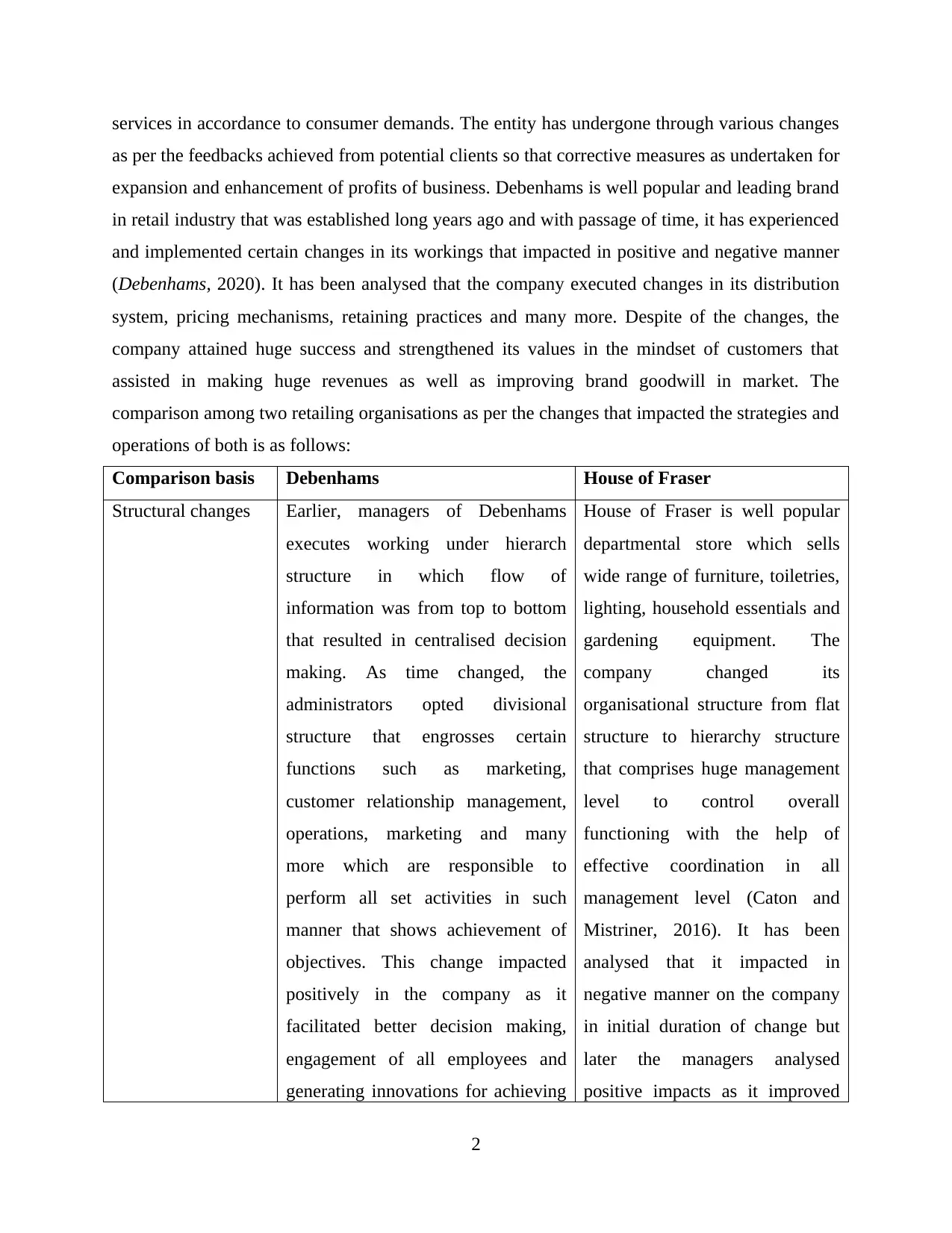
services in accordance to consumer demands. The entity has undergone through various changes
as per the feedbacks achieved from potential clients so that corrective measures as undertaken for
expansion and enhancement of profits of business. Debenhams is well popular and leading brand
in retail industry that was established long years ago and with passage of time, it has experienced
and implemented certain changes in its workings that impacted in positive and negative manner
(Debenhams, 2020). It has been analysed that the company executed changes in its distribution
system, pricing mechanisms, retaining practices and many more. Despite of the changes, the
company attained huge success and strengthened its values in the mindset of customers that
assisted in making huge revenues as well as improving brand goodwill in market. The
comparison among two retailing organisations as per the changes that impacted the strategies and
operations of both is as follows:
Comparison basis Debenhams House of Fraser
Structural changes Earlier, managers of Debenhams
executes working under hierarch
structure in which flow of
information was from top to bottom
that resulted in centralised decision
making. As time changed, the
administrators opted divisional
structure that engrosses certain
functions such as marketing,
customer relationship management,
operations, marketing and many
more which are responsible to
perform all set activities in such
manner that shows achievement of
objectives. This change impacted
positively in the company as it
facilitated better decision making,
engagement of all employees and
generating innovations for achieving
House of Fraser is well popular
departmental store which sells
wide range of furniture, toiletries,
lighting, household essentials and
gardening equipment. The
company changed its
organisational structure from flat
structure to hierarchy structure
that comprises huge management
level to control overall
functioning with the help of
effective coordination in all
management level (Caton and
Mistriner, 2016). It has been
analysed that it impacted in
negative manner on the company
in initial duration of change but
later the managers analysed
positive impacts as it improved
2
as per the feedbacks achieved from potential clients so that corrective measures as undertaken for
expansion and enhancement of profits of business. Debenhams is well popular and leading brand
in retail industry that was established long years ago and with passage of time, it has experienced
and implemented certain changes in its workings that impacted in positive and negative manner
(Debenhams, 2020). It has been analysed that the company executed changes in its distribution
system, pricing mechanisms, retaining practices and many more. Despite of the changes, the
company attained huge success and strengthened its values in the mindset of customers that
assisted in making huge revenues as well as improving brand goodwill in market. The
comparison among two retailing organisations as per the changes that impacted the strategies and
operations of both is as follows:
Comparison basis Debenhams House of Fraser
Structural changes Earlier, managers of Debenhams
executes working under hierarch
structure in which flow of
information was from top to bottom
that resulted in centralised decision
making. As time changed, the
administrators opted divisional
structure that engrosses certain
functions such as marketing,
customer relationship management,
operations, marketing and many
more which are responsible to
perform all set activities in such
manner that shows achievement of
objectives. This change impacted
positively in the company as it
facilitated better decision making,
engagement of all employees and
generating innovations for achieving
House of Fraser is well popular
departmental store which sells
wide range of furniture, toiletries,
lighting, household essentials and
gardening equipment. The
company changed its
organisational structure from flat
structure to hierarchy structure
that comprises huge management
level to control overall
functioning with the help of
effective coordination in all
management level (Caton and
Mistriner, 2016). It has been
analysed that it impacted in
negative manner on the company
in initial duration of change but
later the managers analysed
positive impacts as it improved
2
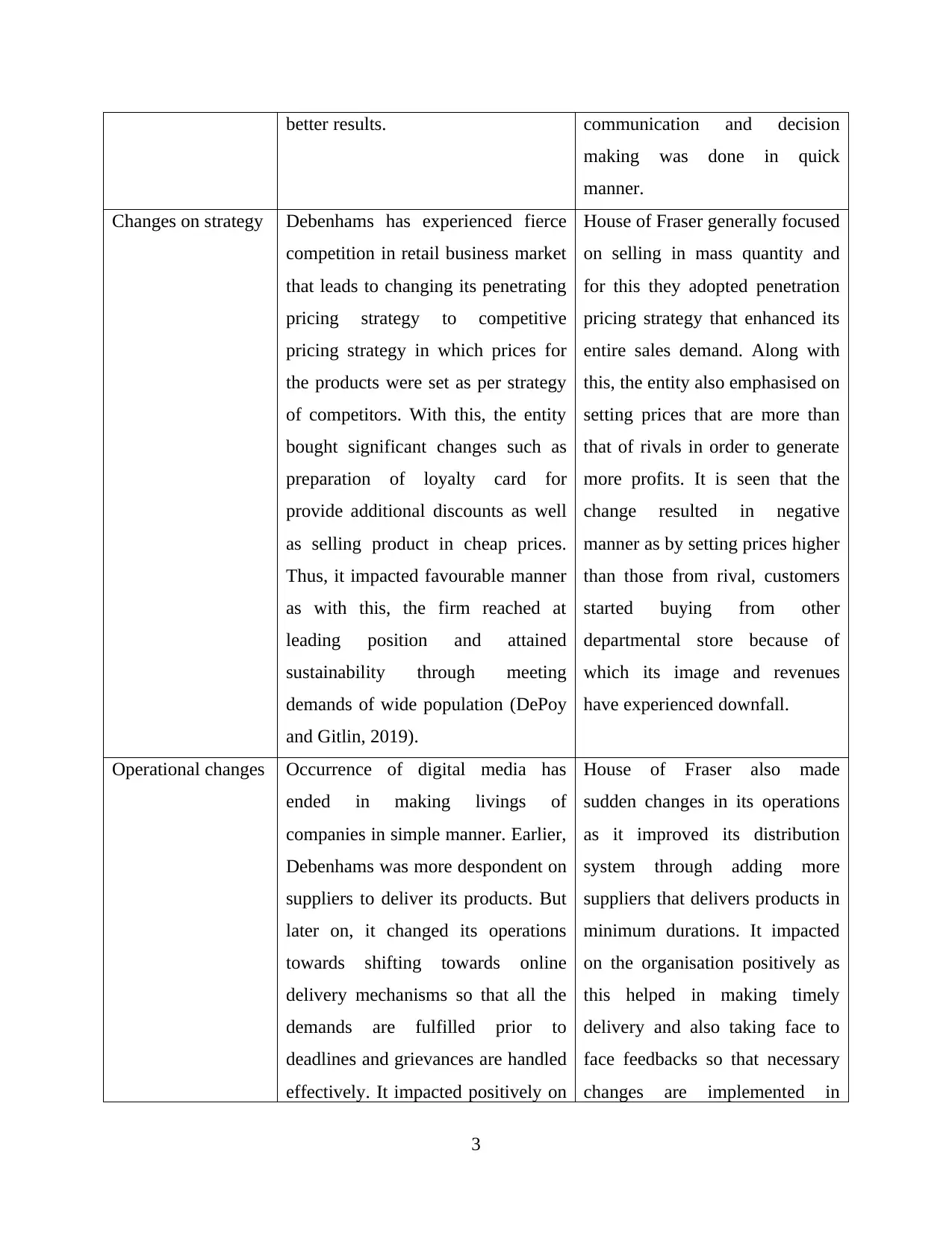
better results. communication and decision
making was done in quick
manner.
Changes on strategy Debenhams has experienced fierce
competition in retail business market
that leads to changing its penetrating
pricing strategy to competitive
pricing strategy in which prices for
the products were set as per strategy
of competitors. With this, the entity
bought significant changes such as
preparation of loyalty card for
provide additional discounts as well
as selling product in cheap prices.
Thus, it impacted favourable manner
as with this, the firm reached at
leading position and attained
sustainability through meeting
demands of wide population (DePoy
and Gitlin, 2019).
House of Fraser generally focused
on selling in mass quantity and
for this they adopted penetration
pricing strategy that enhanced its
entire sales demand. Along with
this, the entity also emphasised on
setting prices that are more than
that of rivals in order to generate
more profits. It is seen that the
change resulted in negative
manner as by setting prices higher
than those from rival, customers
started buying from other
departmental store because of
which its image and revenues
have experienced downfall.
Operational changes Occurrence of digital media has
ended in making livings of
companies in simple manner. Earlier,
Debenhams was more despondent on
suppliers to deliver its products. But
later on, it changed its operations
towards shifting towards online
delivery mechanisms so that all the
demands are fulfilled prior to
deadlines and grievances are handled
effectively. It impacted positively on
House of Fraser also made
sudden changes in its operations
as it improved its distribution
system through adding more
suppliers that delivers products in
minimum durations. It impacted
on the organisation positively as
this helped in making timely
delivery and also taking face to
face feedbacks so that necessary
changes are implemented in
3
making was done in quick
manner.
Changes on strategy Debenhams has experienced fierce
competition in retail business market
that leads to changing its penetrating
pricing strategy to competitive
pricing strategy in which prices for
the products were set as per strategy
of competitors. With this, the entity
bought significant changes such as
preparation of loyalty card for
provide additional discounts as well
as selling product in cheap prices.
Thus, it impacted favourable manner
as with this, the firm reached at
leading position and attained
sustainability through meeting
demands of wide population (DePoy
and Gitlin, 2019).
House of Fraser generally focused
on selling in mass quantity and
for this they adopted penetration
pricing strategy that enhanced its
entire sales demand. Along with
this, the entity also emphasised on
setting prices that are more than
that of rivals in order to generate
more profits. It is seen that the
change resulted in negative
manner as by setting prices higher
than those from rival, customers
started buying from other
departmental store because of
which its image and revenues
have experienced downfall.
Operational changes Occurrence of digital media has
ended in making livings of
companies in simple manner. Earlier,
Debenhams was more despondent on
suppliers to deliver its products. But
later on, it changed its operations
towards shifting towards online
delivery mechanisms so that all the
demands are fulfilled prior to
deadlines and grievances are handled
effectively. It impacted positively on
House of Fraser also made
sudden changes in its operations
as it improved its distribution
system through adding more
suppliers that delivers products in
minimum durations. It impacted
on the organisation positively as
this helped in making timely
delivery and also taking face to
face feedbacks so that necessary
changes are implemented in
3
⊘ This is a preview!⊘
Do you want full access?
Subscribe today to unlock all pages.

Trusted by 1+ million students worldwide
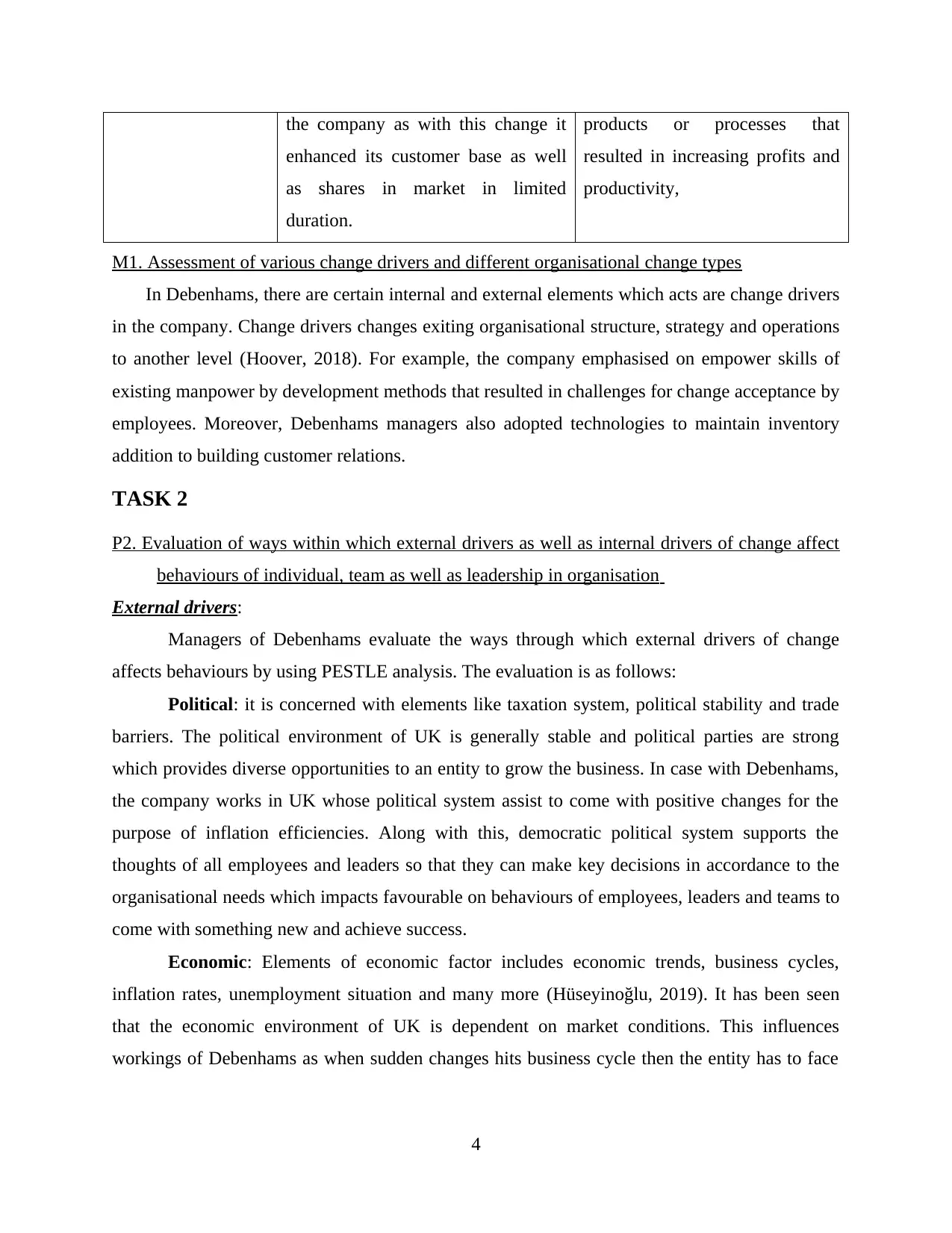
the company as with this change it
enhanced its customer base as well
as shares in market in limited
duration.
products or processes that
resulted in increasing profits and
productivity,
M1. Assessment of various change drivers and different organisational change types
In Debenhams, there are certain internal and external elements which acts are change drivers
in the company. Change drivers changes exiting organisational structure, strategy and operations
to another level (Hoover, 2018). For example, the company emphasised on empower skills of
existing manpower by development methods that resulted in challenges for change acceptance by
employees. Moreover, Debenhams managers also adopted technologies to maintain inventory
addition to building customer relations.
TASK 2
P2. Evaluation of ways within which external drivers as well as internal drivers of change affect
behaviours of individual, team as well as leadership in organisation
External drivers:
Managers of Debenhams evaluate the ways through which external drivers of change
affects behaviours by using PESTLE analysis. The evaluation is as follows:
Political: it is concerned with elements like taxation system, political stability and trade
barriers. The political environment of UK is generally stable and political parties are strong
which provides diverse opportunities to an entity to grow the business. In case with Debenhams,
the company works in UK whose political system assist to come with positive changes for the
purpose of inflation efficiencies. Along with this, democratic political system supports the
thoughts of all employees and leaders so that they can make key decisions in accordance to the
organisational needs which impacts favourable on behaviours of employees, leaders and teams to
come with something new and achieve success.
Economic: Elements of economic factor includes economic trends, business cycles,
inflation rates, unemployment situation and many more (Hüseyinoğlu, 2019). It has been seen
that the economic environment of UK is dependent on market conditions. This influences
workings of Debenhams as when sudden changes hits business cycle then the entity has to face
4
enhanced its customer base as well
as shares in market in limited
duration.
products or processes that
resulted in increasing profits and
productivity,
M1. Assessment of various change drivers and different organisational change types
In Debenhams, there are certain internal and external elements which acts are change drivers
in the company. Change drivers changes exiting organisational structure, strategy and operations
to another level (Hoover, 2018). For example, the company emphasised on empower skills of
existing manpower by development methods that resulted in challenges for change acceptance by
employees. Moreover, Debenhams managers also adopted technologies to maintain inventory
addition to building customer relations.
TASK 2
P2. Evaluation of ways within which external drivers as well as internal drivers of change affect
behaviours of individual, team as well as leadership in organisation
External drivers:
Managers of Debenhams evaluate the ways through which external drivers of change
affects behaviours by using PESTLE analysis. The evaluation is as follows:
Political: it is concerned with elements like taxation system, political stability and trade
barriers. The political environment of UK is generally stable and political parties are strong
which provides diverse opportunities to an entity to grow the business. In case with Debenhams,
the company works in UK whose political system assist to come with positive changes for the
purpose of inflation efficiencies. Along with this, democratic political system supports the
thoughts of all employees and leaders so that they can make key decisions in accordance to the
organisational needs which impacts favourable on behaviours of employees, leaders and teams to
come with something new and achieve success.
Economic: Elements of economic factor includes economic trends, business cycles,
inflation rates, unemployment situation and many more (Hüseyinoğlu, 2019). It has been seen
that the economic environment of UK is dependent on market conditions. This influences
workings of Debenhams as when sudden changes hits business cycle then the entity has to face
4
Paraphrase This Document
Need a fresh take? Get an instant paraphrase of this document with our AI Paraphraser
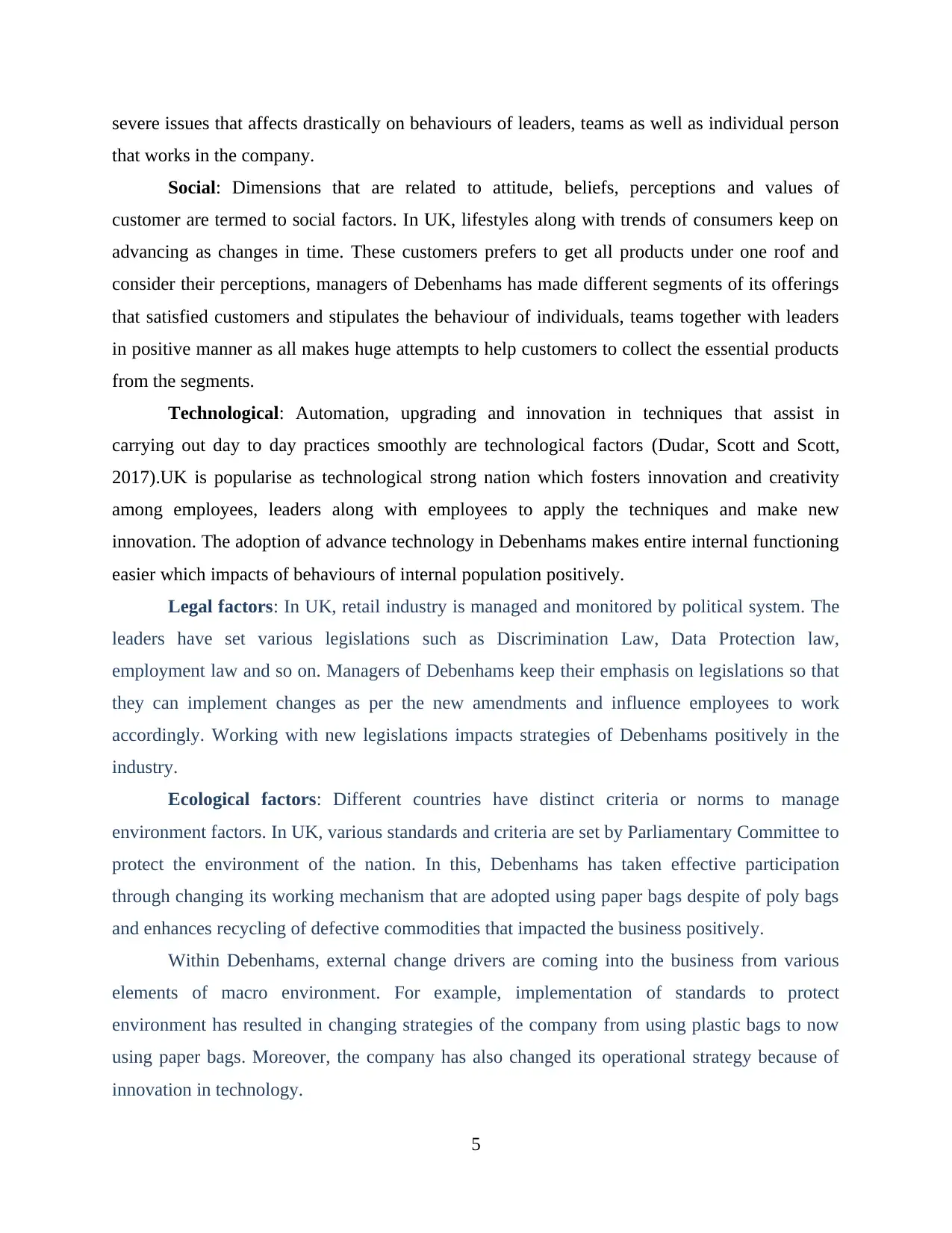
severe issues that affects drastically on behaviours of leaders, teams as well as individual person
that works in the company.
Social: Dimensions that are related to attitude, beliefs, perceptions and values of
customer are termed to social factors. In UK, lifestyles along with trends of consumers keep on
advancing as changes in time. These customers prefers to get all products under one roof and
consider their perceptions, managers of Debenhams has made different segments of its offerings
that satisfied customers and stipulates the behaviour of individuals, teams together with leaders
in positive manner as all makes huge attempts to help customers to collect the essential products
from the segments.
Technological: Automation, upgrading and innovation in techniques that assist in
carrying out day to day practices smoothly are technological factors (Dudar, Scott and Scott,
2017).UK is popularise as technological strong nation which fosters innovation and creativity
among employees, leaders along with employees to apply the techniques and make new
innovation. The adoption of advance technology in Debenhams makes entire internal functioning
easier which impacts of behaviours of internal population positively.
Legal factors: In UK, retail industry is managed and monitored by political system. The
leaders have set various legislations such as Discrimination Law, Data Protection law,
employment law and so on. Managers of Debenhams keep their emphasis on legislations so that
they can implement changes as per the new amendments and influence employees to work
accordingly. Working with new legislations impacts strategies of Debenhams positively in the
industry.
Ecological factors: Different countries have distinct criteria or norms to manage
environment factors. In UK, various standards and criteria are set by Parliamentary Committee to
protect the environment of the nation. In this, Debenhams has taken effective participation
through changing its working mechanism that are adopted using paper bags despite of poly bags
and enhances recycling of defective commodities that impacted the business positively.
Within Debenhams, external change drivers are coming into the business from various
elements of macro environment. For example, implementation of standards to protect
environment has resulted in changing strategies of the company from using plastic bags to now
using paper bags. Moreover, the company has also changed its operational strategy because of
innovation in technology.
5
that works in the company.
Social: Dimensions that are related to attitude, beliefs, perceptions and values of
customer are termed to social factors. In UK, lifestyles along with trends of consumers keep on
advancing as changes in time. These customers prefers to get all products under one roof and
consider their perceptions, managers of Debenhams has made different segments of its offerings
that satisfied customers and stipulates the behaviour of individuals, teams together with leaders
in positive manner as all makes huge attempts to help customers to collect the essential products
from the segments.
Technological: Automation, upgrading and innovation in techniques that assist in
carrying out day to day practices smoothly are technological factors (Dudar, Scott and Scott,
2017).UK is popularise as technological strong nation which fosters innovation and creativity
among employees, leaders along with employees to apply the techniques and make new
innovation. The adoption of advance technology in Debenhams makes entire internal functioning
easier which impacts of behaviours of internal population positively.
Legal factors: In UK, retail industry is managed and monitored by political system. The
leaders have set various legislations such as Discrimination Law, Data Protection law,
employment law and so on. Managers of Debenhams keep their emphasis on legislations so that
they can implement changes as per the new amendments and influence employees to work
accordingly. Working with new legislations impacts strategies of Debenhams positively in the
industry.
Ecological factors: Different countries have distinct criteria or norms to manage
environment factors. In UK, various standards and criteria are set by Parliamentary Committee to
protect the environment of the nation. In this, Debenhams has taken effective participation
through changing its working mechanism that are adopted using paper bags despite of poly bags
and enhances recycling of defective commodities that impacted the business positively.
Within Debenhams, external change drivers are coming into the business from various
elements of macro environment. For example, implementation of standards to protect
environment has resulted in changing strategies of the company from using plastic bags to now
using paper bags. Moreover, the company has also changed its operational strategy because of
innovation in technology.
5
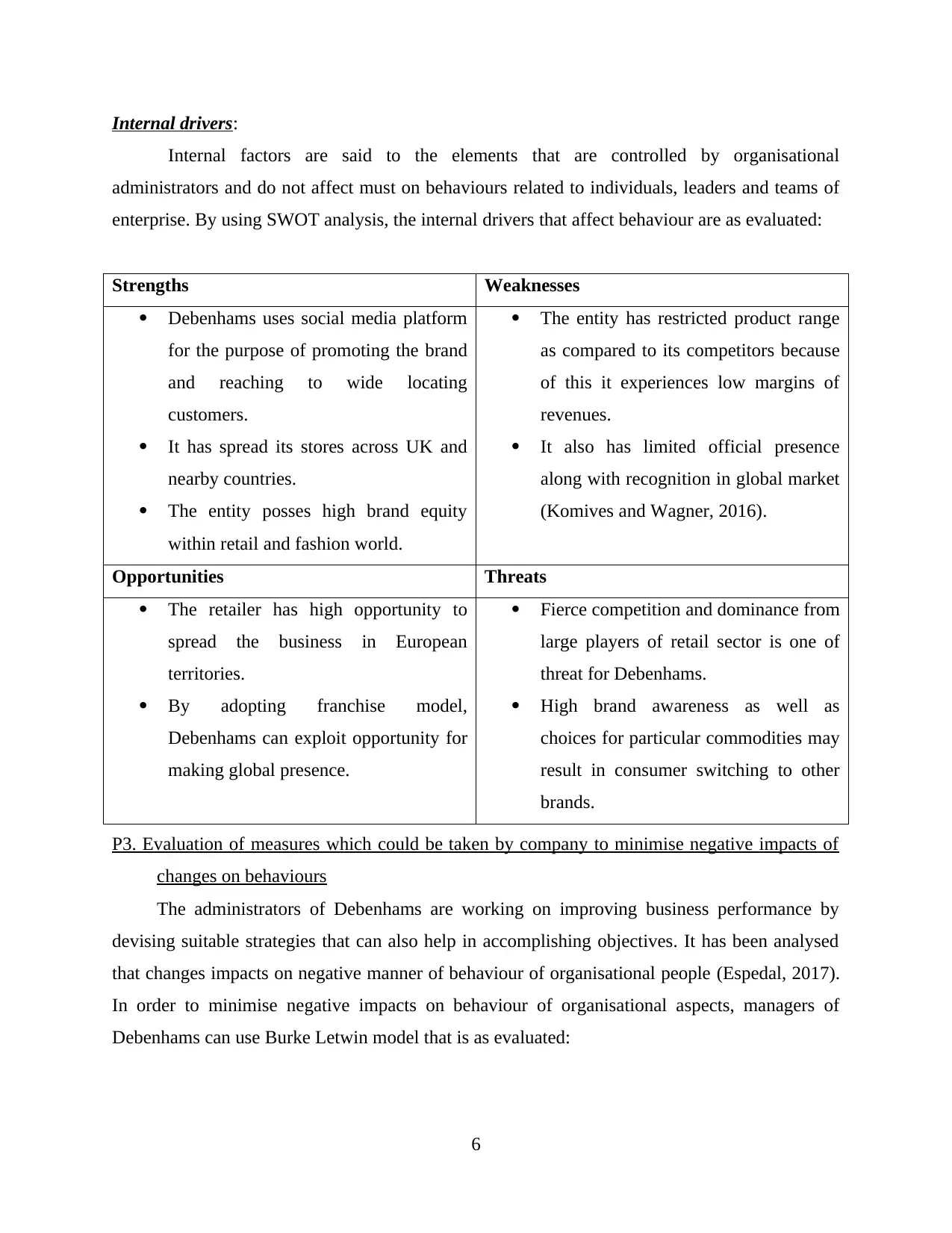
Internal drivers:
Internal factors are said to the elements that are controlled by organisational
administrators and do not affect must on behaviours related to individuals, leaders and teams of
enterprise. By using SWOT analysis, the internal drivers that affect behaviour are as evaluated:
Strengths Weaknesses
Debenhams uses social media platform
for the purpose of promoting the brand
and reaching to wide locating
customers.
It has spread its stores across UK and
nearby countries.
The entity posses high brand equity
within retail and fashion world.
The entity has restricted product range
as compared to its competitors because
of this it experiences low margins of
revenues.
It also has limited official presence
along with recognition in global market
(Komives and Wagner, 2016).
Opportunities Threats
The retailer has high opportunity to
spread the business in European
territories.
By adopting franchise model,
Debenhams can exploit opportunity for
making global presence.
Fierce competition and dominance from
large players of retail sector is one of
threat for Debenhams.
High brand awareness as well as
choices for particular commodities may
result in consumer switching to other
brands.
P3. Evaluation of measures which could be taken by company to minimise negative impacts of
changes on behaviours
The administrators of Debenhams are working on improving business performance by
devising suitable strategies that can also help in accomplishing objectives. It has been analysed
that changes impacts on negative manner of behaviour of organisational people (Espedal, 2017).
In order to minimise negative impacts on behaviour of organisational aspects, managers of
Debenhams can use Burke Letwin model that is as evaluated:
6
Internal factors are said to the elements that are controlled by organisational
administrators and do not affect must on behaviours related to individuals, leaders and teams of
enterprise. By using SWOT analysis, the internal drivers that affect behaviour are as evaluated:
Strengths Weaknesses
Debenhams uses social media platform
for the purpose of promoting the brand
and reaching to wide locating
customers.
It has spread its stores across UK and
nearby countries.
The entity posses high brand equity
within retail and fashion world.
The entity has restricted product range
as compared to its competitors because
of this it experiences low margins of
revenues.
It also has limited official presence
along with recognition in global market
(Komives and Wagner, 2016).
Opportunities Threats
The retailer has high opportunity to
spread the business in European
territories.
By adopting franchise model,
Debenhams can exploit opportunity for
making global presence.
Fierce competition and dominance from
large players of retail sector is one of
threat for Debenhams.
High brand awareness as well as
choices for particular commodities may
result in consumer switching to other
brands.
P3. Evaluation of measures which could be taken by company to minimise negative impacts of
changes on behaviours
The administrators of Debenhams are working on improving business performance by
devising suitable strategies that can also help in accomplishing objectives. It has been analysed
that changes impacts on negative manner of behaviour of organisational people (Espedal, 2017).
In order to minimise negative impacts on behaviour of organisational aspects, managers of
Debenhams can use Burke Letwin model that is as evaluated:
6
⊘ This is a preview!⊘
Do you want full access?
Subscribe today to unlock all pages.

Trusted by 1+ million students worldwide
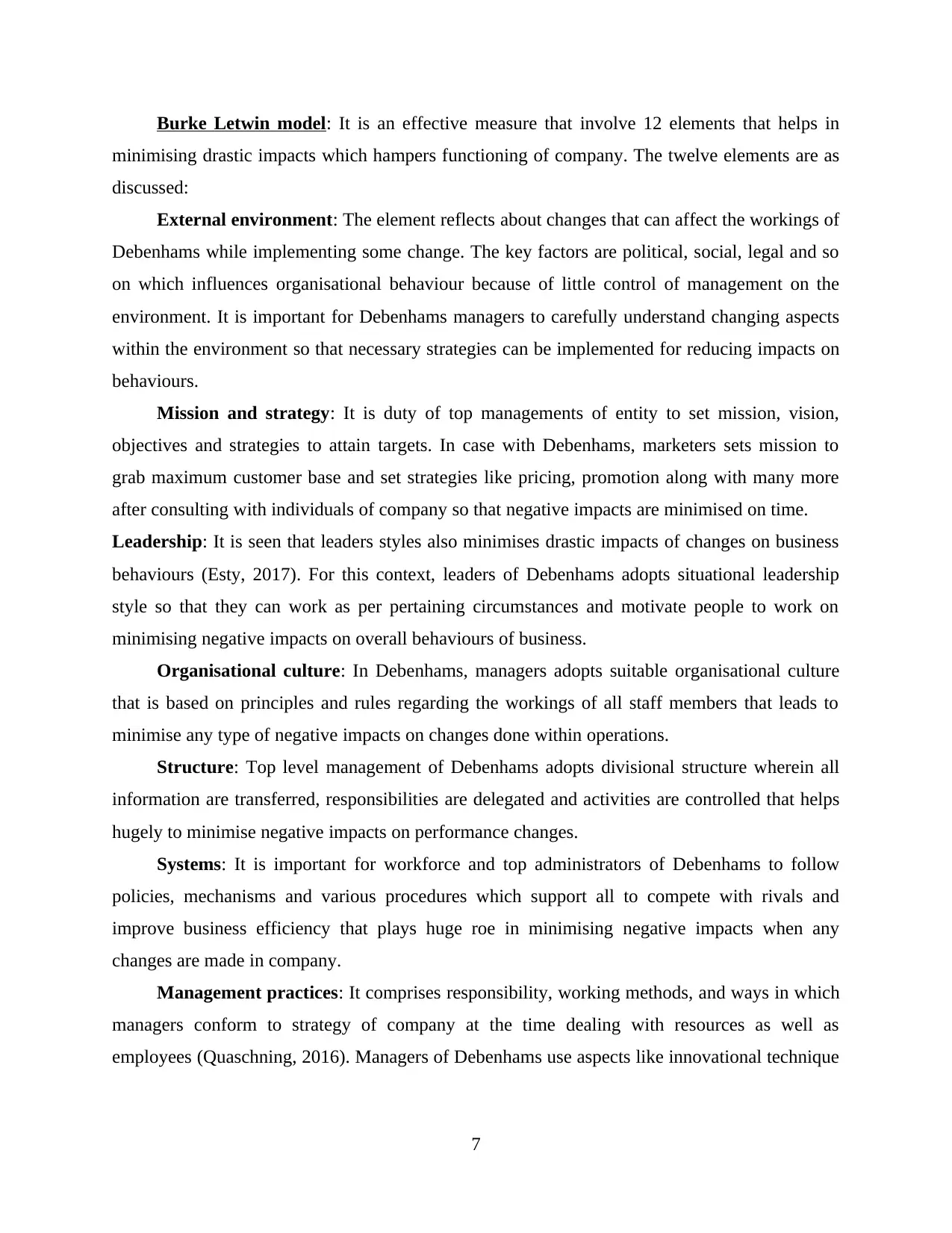
Burke Letwin model: It is an effective measure that involve 12 elements that helps in
minimising drastic impacts which hampers functioning of company. The twelve elements are as
discussed:
External environment: The element reflects about changes that can affect the workings of
Debenhams while implementing some change. The key factors are political, social, legal and so
on which influences organisational behaviour because of little control of management on the
environment. It is important for Debenhams managers to carefully understand changing aspects
within the environment so that necessary strategies can be implemented for reducing impacts on
behaviours.
Mission and strategy: It is duty of top managements of entity to set mission, vision,
objectives and strategies to attain targets. In case with Debenhams, marketers sets mission to
grab maximum customer base and set strategies like pricing, promotion along with many more
after consulting with individuals of company so that negative impacts are minimised on time.
Leadership: It is seen that leaders styles also minimises drastic impacts of changes on business
behaviours (Esty, 2017). For this context, leaders of Debenhams adopts situational leadership
style so that they can work as per pertaining circumstances and motivate people to work on
minimising negative impacts on overall behaviours of business.
Organisational culture: In Debenhams, managers adopts suitable organisational culture
that is based on principles and rules regarding the workings of all staff members that leads to
minimise any type of negative impacts on changes done within operations.
Structure: Top level management of Debenhams adopts divisional structure wherein all
information are transferred, responsibilities are delegated and activities are controlled that helps
hugely to minimise negative impacts on performance changes.
Systems: It is important for workforce and top administrators of Debenhams to follow
policies, mechanisms and various procedures which support all to compete with rivals and
improve business efficiency that plays huge roe in minimising negative impacts when any
changes are made in company.
Management practices: It comprises responsibility, working methods, and ways in which
managers conform to strategy of company at the time dealing with resources as well as
employees (Quaschning, 2016). Managers of Debenhams use aspects like innovational technique
7
minimising drastic impacts which hampers functioning of company. The twelve elements are as
discussed:
External environment: The element reflects about changes that can affect the workings of
Debenhams while implementing some change. The key factors are political, social, legal and so
on which influences organisational behaviour because of little control of management on the
environment. It is important for Debenhams managers to carefully understand changing aspects
within the environment so that necessary strategies can be implemented for reducing impacts on
behaviours.
Mission and strategy: It is duty of top managements of entity to set mission, vision,
objectives and strategies to attain targets. In case with Debenhams, marketers sets mission to
grab maximum customer base and set strategies like pricing, promotion along with many more
after consulting with individuals of company so that negative impacts are minimised on time.
Leadership: It is seen that leaders styles also minimises drastic impacts of changes on business
behaviours (Esty, 2017). For this context, leaders of Debenhams adopts situational leadership
style so that they can work as per pertaining circumstances and motivate people to work on
minimising negative impacts on overall behaviours of business.
Organisational culture: In Debenhams, managers adopts suitable organisational culture
that is based on principles and rules regarding the workings of all staff members that leads to
minimise any type of negative impacts on changes done within operations.
Structure: Top level management of Debenhams adopts divisional structure wherein all
information are transferred, responsibilities are delegated and activities are controlled that helps
hugely to minimise negative impacts on performance changes.
Systems: It is important for workforce and top administrators of Debenhams to follow
policies, mechanisms and various procedures which support all to compete with rivals and
improve business efficiency that plays huge roe in minimising negative impacts when any
changes are made in company.
Management practices: It comprises responsibility, working methods, and ways in which
managers conform to strategy of company at the time dealing with resources as well as
employees (Quaschning, 2016). Managers of Debenhams use aspects like innovational technique
7
Paraphrase This Document
Need a fresh take? Get an instant paraphrase of this document with our AI Paraphraser
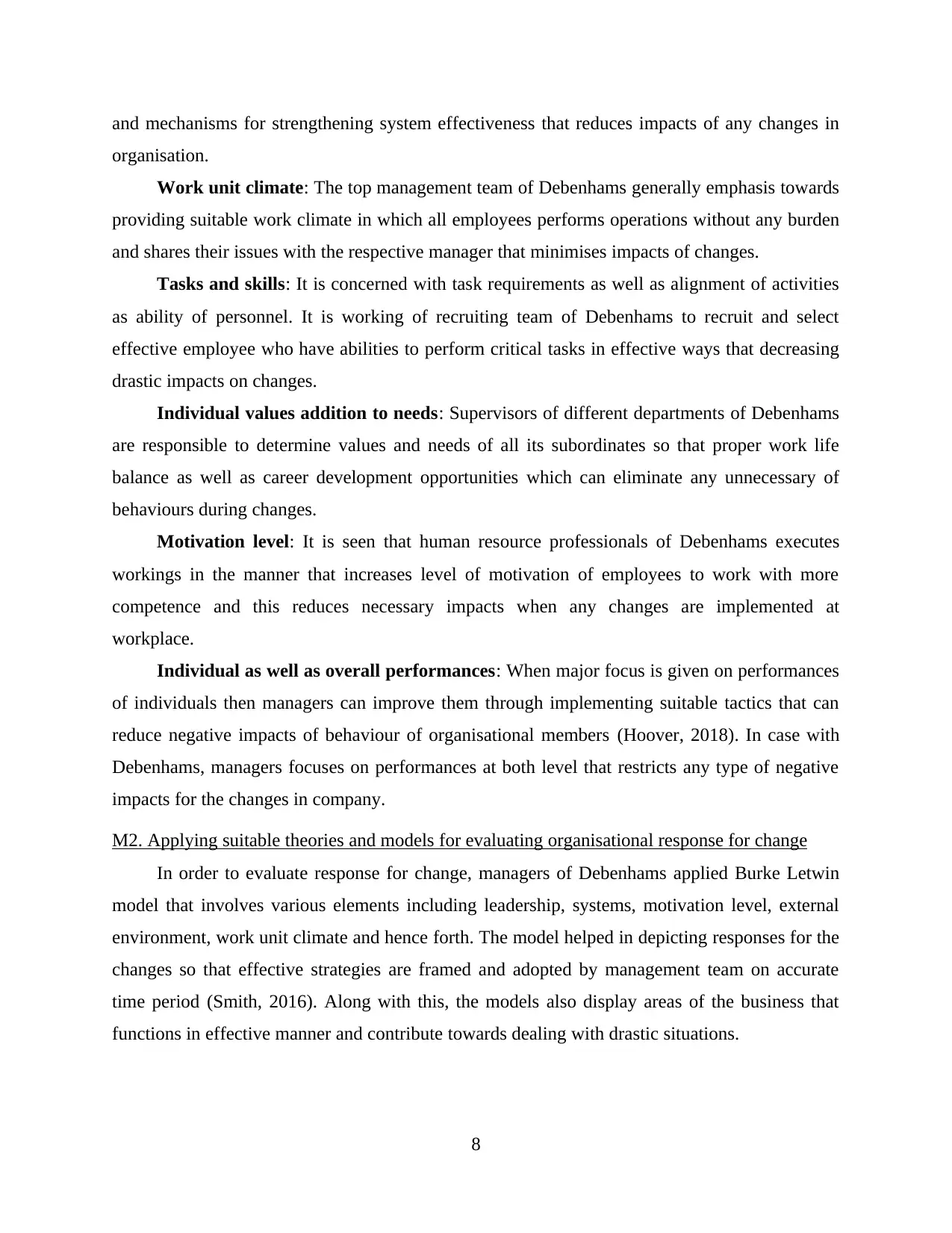
and mechanisms for strengthening system effectiveness that reduces impacts of any changes in
organisation.
Work unit climate: The top management team of Debenhams generally emphasis towards
providing suitable work climate in which all employees performs operations without any burden
and shares their issues with the respective manager that minimises impacts of changes.
Tasks and skills: It is concerned with task requirements as well as alignment of activities
as ability of personnel. It is working of recruiting team of Debenhams to recruit and select
effective employee who have abilities to perform critical tasks in effective ways that decreasing
drastic impacts on changes.
Individual values addition to needs: Supervisors of different departments of Debenhams
are responsible to determine values and needs of all its subordinates so that proper work life
balance as well as career development opportunities which can eliminate any unnecessary of
behaviours during changes.
Motivation level: It is seen that human resource professionals of Debenhams executes
workings in the manner that increases level of motivation of employees to work with more
competence and this reduces necessary impacts when any changes are implemented at
workplace.
Individual as well as overall performances: When major focus is given on performances
of individuals then managers can improve them through implementing suitable tactics that can
reduce negative impacts of behaviour of organisational members (Hoover, 2018). In case with
Debenhams, managers focuses on performances at both level that restricts any type of negative
impacts for the changes in company.
M2. Applying suitable theories and models for evaluating organisational response for change
In order to evaluate response for change, managers of Debenhams applied Burke Letwin
model that involves various elements including leadership, systems, motivation level, external
environment, work unit climate and hence forth. The model helped in depicting responses for the
changes so that effective strategies are framed and adopted by management team on accurate
time period (Smith, 2016). Along with this, the models also display areas of the business that
functions in effective manner and contribute towards dealing with drastic situations.
8
organisation.
Work unit climate: The top management team of Debenhams generally emphasis towards
providing suitable work climate in which all employees performs operations without any burden
and shares their issues with the respective manager that minimises impacts of changes.
Tasks and skills: It is concerned with task requirements as well as alignment of activities
as ability of personnel. It is working of recruiting team of Debenhams to recruit and select
effective employee who have abilities to perform critical tasks in effective ways that decreasing
drastic impacts on changes.
Individual values addition to needs: Supervisors of different departments of Debenhams
are responsible to determine values and needs of all its subordinates so that proper work life
balance as well as career development opportunities which can eliminate any unnecessary of
behaviours during changes.
Motivation level: It is seen that human resource professionals of Debenhams executes
workings in the manner that increases level of motivation of employees to work with more
competence and this reduces necessary impacts when any changes are implemented at
workplace.
Individual as well as overall performances: When major focus is given on performances
of individuals then managers can improve them through implementing suitable tactics that can
reduce negative impacts of behaviour of organisational members (Hoover, 2018). In case with
Debenhams, managers focuses on performances at both level that restricts any type of negative
impacts for the changes in company.
M2. Applying suitable theories and models for evaluating organisational response for change
In order to evaluate response for change, managers of Debenhams applied Burke Letwin
model that involves various elements including leadership, systems, motivation level, external
environment, work unit climate and hence forth. The model helped in depicting responses for the
changes so that effective strategies are framed and adopted by management team on accurate
time period (Smith, 2016). Along with this, the models also display areas of the business that
functions in effective manner and contribute towards dealing with drastic situations.
8
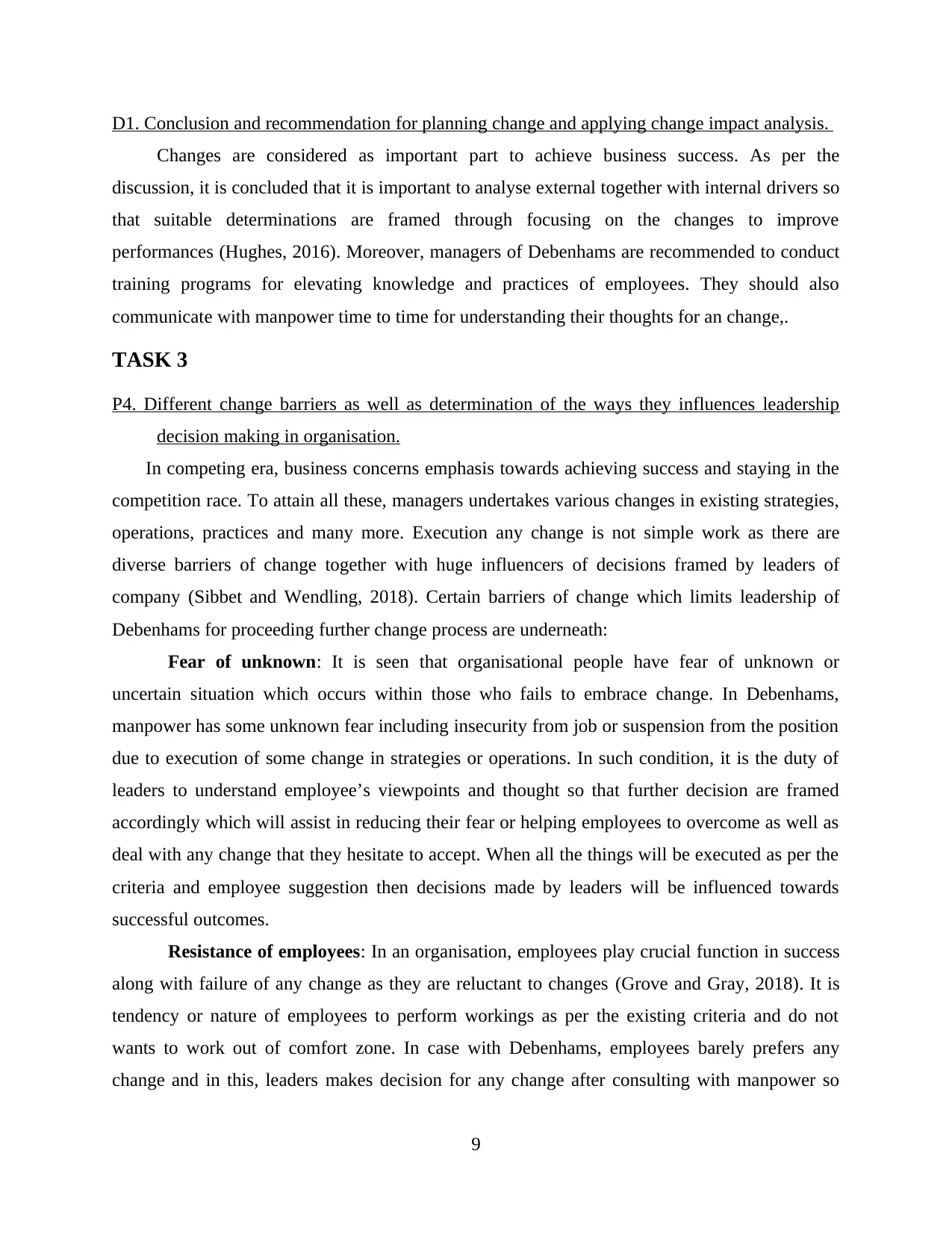
D1. Conclusion and recommendation for planning change and applying change impact analysis.
Changes are considered as important part to achieve business success. As per the
discussion, it is concluded that it is important to analyse external together with internal drivers so
that suitable determinations are framed through focusing on the changes to improve
performances (Hughes, 2016). Moreover, managers of Debenhams are recommended to conduct
training programs for elevating knowledge and practices of employees. They should also
communicate with manpower time to time for understanding their thoughts for an change,.
TASK 3
P4. Different change barriers as well as determination of the ways they influences leadership
decision making in organisation.
In competing era, business concerns emphasis towards achieving success and staying in the
competition race. To attain all these, managers undertakes various changes in existing strategies,
operations, practices and many more. Execution any change is not simple work as there are
diverse barriers of change together with huge influencers of decisions framed by leaders of
company (Sibbet and Wendling, 2018). Certain barriers of change which limits leadership of
Debenhams for proceeding further change process are underneath:
Fear of unknown: It is seen that organisational people have fear of unknown or
uncertain situation which occurs within those who fails to embrace change. In Debenhams,
manpower has some unknown fear including insecurity from job or suspension from the position
due to execution of some change in strategies or operations. In such condition, it is the duty of
leaders to understand employee’s viewpoints and thought so that further decision are framed
accordingly which will assist in reducing their fear or helping employees to overcome as well as
deal with any change that they hesitate to accept. When all the things will be executed as per the
criteria and employee suggestion then decisions made by leaders will be influenced towards
successful outcomes.
Resistance of employees: In an organisation, employees play crucial function in success
along with failure of any change as they are reluctant to changes (Grove and Gray, 2018). It is
tendency or nature of employees to perform workings as per the existing criteria and do not
wants to work out of comfort zone. In case with Debenhams, employees barely prefers any
change and in this, leaders makes decision for any change after consulting with manpower so
9
Changes are considered as important part to achieve business success. As per the
discussion, it is concluded that it is important to analyse external together with internal drivers so
that suitable determinations are framed through focusing on the changes to improve
performances (Hughes, 2016). Moreover, managers of Debenhams are recommended to conduct
training programs for elevating knowledge and practices of employees. They should also
communicate with manpower time to time for understanding their thoughts for an change,.
TASK 3
P4. Different change barriers as well as determination of the ways they influences leadership
decision making in organisation.
In competing era, business concerns emphasis towards achieving success and staying in the
competition race. To attain all these, managers undertakes various changes in existing strategies,
operations, practices and many more. Execution any change is not simple work as there are
diverse barriers of change together with huge influencers of decisions framed by leaders of
company (Sibbet and Wendling, 2018). Certain barriers of change which limits leadership of
Debenhams for proceeding further change process are underneath:
Fear of unknown: It is seen that organisational people have fear of unknown or
uncertain situation which occurs within those who fails to embrace change. In Debenhams,
manpower has some unknown fear including insecurity from job or suspension from the position
due to execution of some change in strategies or operations. In such condition, it is the duty of
leaders to understand employee’s viewpoints and thought so that further decision are framed
accordingly which will assist in reducing their fear or helping employees to overcome as well as
deal with any change that they hesitate to accept. When all the things will be executed as per the
criteria and employee suggestion then decisions made by leaders will be influenced towards
successful outcomes.
Resistance of employees: In an organisation, employees play crucial function in success
along with failure of any change as they are reluctant to changes (Grove and Gray, 2018). It is
tendency or nature of employees to perform workings as per the existing criteria and do not
wants to work out of comfort zone. In case with Debenhams, employees barely prefers any
change and in this, leaders makes decision for any change after consulting with manpower so
9
⊘ This is a preview!⊘
Do you want full access?
Subscribe today to unlock all pages.

Trusted by 1+ million students worldwide
1 out of 21
Related Documents
Your All-in-One AI-Powered Toolkit for Academic Success.
+13062052269
info@desklib.com
Available 24*7 on WhatsApp / Email
![[object Object]](/_next/static/media/star-bottom.7253800d.svg)
Unlock your academic potential
Copyright © 2020–2025 A2Z Services. All Rights Reserved. Developed and managed by ZUCOL.




